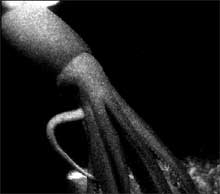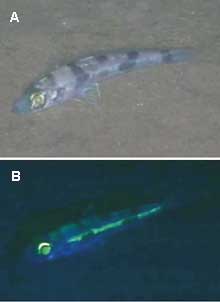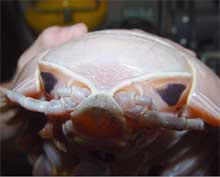
First ever in situ footage of an undescribed species of deep-sea squid. Click image for larger view and image credit.
Operation Deep Scope 2005: Mission Plan
Tamara Frank, Ph.D.
Biological Oceanographer
Harbor Branch Oceanographic Institution
Operation Deep Scope 2004 looked into the deep ocean with new eyes and revealed new organisms, behaviors, visual adaptations, and fluorescent compounds. Notable results from this mission included the discovery of a fluorescent shark, the fluorescence of methane hydrates, the first in situ footage of a large, undescribed species of deep-sea squid, the discovery of a bioluminescent anemone, the discovery that animals that appear to be transparent in the open ocean are clearly visible under polarized light, and the discovery that organisms collected under bright submersible lights are irreparably blinded. On Operation Deep Scope 2005, we will extend the envelope of this exciting frontier in ocean exploration with even more methods of seeing and collecting. Our target field sites will be some deep Lophelia lithoherms on the southwest Florida shelf, Viosca Knoll and the unexplored pinnacles on the west margin of DeSoto Canyon in the northern Gulf of Mexico. Read more on the dive sites in the Geology essay.
Characterizing deep-sea habitats
Characterizing deep-sea benthic (bottom) and pelagic (water column) ecosystems has proven to be a great challenge in the deep-sea environment, as many of the large predators flee from noisy, brightly lit submersibles and ROVs. In addition to the temporary disruption of normal behavior, animals with photoreceptors designed for the dimly lit deep-sea environment are often permanently blinded by the very lights we use to find them. Our assumption that everything sees the way we see has also affected descriptions of animal interactions, in that animals that may be transparent, and therefore virtually invisible to humans under bright submersible lights, are much more visible to animals with polarization and/or UV sensitivity.
Deep Scope 2004 brought together an international team of investigators, all interested in various aspects of light and how it affects animal interactions. Due to the multidisciplinary nature of the research, numerous scientists were able to collect data on each submersible dive, resulting in a wealth of data rarely seen on such a short mission. Operation Deep Scope 2005 seeks to build on results of 2004, continuing our studies with proven technologies, as well as using new technologies. During the Deep-Scope 2005 mission, our objectives are to:
1) Continue unobtrusive observations
During Deep Scope 2004, a unique deep-sea observatory called Eye-in-the-Sea (EITS) was deployed by the Johnson-Sea-Link (JSL) submersible at three different locations on the sea floor. This battery powered camera system uses a red-light emitting diodein combination with a low-light level camera. Data recorded by EITS during this initial deployment included the first ever in situ footage of a large (> 2 m length), previously undescribed species of deep-sea squid (M. Vecchione pers. comm.). However, during deployments over the last two years, it became clear that some fish were responding to red light illumination. For Deep Scope 2005, the lighting system on EITS will be modified to incorporate some high intensity far-red LEDs used together with a long pass filter to filter out any shorter wavelengths that these animals might be responding to.
In addition to making observations under the new illumination system, behavioral responses to a variety of artificial bioluminescent lures will be tested, in hopes of getting more information on the role of bioluminescence in the deep-sea environment

The shortnose greeneye fish, Chlorophtalmus agassizi (in situ images). A: White light. B: Fluorescence. Click image for larger view and image credit.
2) Determine ecological roles of fluorescence in marine organisms
Visual displays are one of the most important means of communication between organisms, at both within- and between-species levels. In the shallow oceanic environment (0-10 m), the spectrum of the ambient light is broad enough for pigments to generate color displays, such as in coral reef fishes. Deep in the ocean, where there is very little ambient light (below 700-1000 m), bioluminescence is the only way to send a visual signal. At intermediate depths (100 - 300 m), which are still relatively well lit during daytime, neither of these mechanisms function efficiently. There is too much light for a bioluminescent flash to stand out against the background, while color displays based on pigments are impossible since the downwelling light does not contain enough spectral diversity – everything appears in various shades of blue. The only way to generate a color other than blue under such circumstances is to use a fluorescent compound (fluorochrome), which absorbs blue light and emits light of another (longer wavelength) color (green, yellow, orange or red). Therefore, fluorescence may be a major mechanism of visual communication between organisms at intermediate depths.
During Deep Scope 2004, fluorescence imagery was used to detect camouflaged animals that were otherwise difficult to see. Under fluorescence imagery, benthic animals that were virtually invisible under white light became very visible. We plan to continue to search on this mission for deep-sea organisms in which fluorescence is likely to be functional. We hope to obtain a more complete picture of deep-sea benthic fluorescence and develop ideas about its possible functions from the spectral characteristics and patterns observed in the animals. In particular, we would like to assess the possibility that the fluorescence of some animals may be stimulated by bioluminescence produced by other organisms. This understanding of fluorescence responses is being investigated as a tool for automated spectral image classification of bottom habitats (Mazel et al. 2003).
3) Quantify the deep-sea light environment as it is perceived by its inhabitants
The Operation Deep Scope 2004 cruise greatly increased our knowledge of camouflage in the ocean. Two of the most notable results were that: 1) the colors of both benthic and pelagic animals are very well matched for camouflage, and 2) the ultimate camouflage, invisibility, can be broken by animals with the ability to see polarized light. On Deep-Scope 2005, we plan to extend these studies, looking at UV vision as a way of detecting transparent animals. We’re going to examine the sensory world of UV-visual species by filming transparent animals underwater using specialized UV cameras and by measuring the underwater UV levels using spectroradiometers. We also plan to film and photograph transparent animals at UV wavelengths. In addition, we will be measuring the levels of UV light in situ, and comparing these results with measurements of UV visual sensitivity in animals collected from near-surface waters.
In order to examine the deep-sea environment from the perspective of the animals living there, we’re going to modify the lights and cameras on the sub to function as “animal eyes”. Almost all deep-sea visual systems studied to date are sensitive to only blue-green light, and that also happens to be the color of the remaining background light in the deep-sea. Therefore, full color imaging of animals illuminated by full-spectrum lighting gives us a very poor understanding of the deep-sea world as seen by its inhabitants. Many animals that appear conspicuous to us are in fact well camouflaged. Certain body patterns visible to us may not be visible at depth. In order the see the deep-sea environment the way a deep-sea animal would, lights of the Johnson-Sea-Link submersible will be covered with filters that, together with the spectral emission of the lights and the spectral response of the video camera, mimic the response of the typical deep-sea visual system under the ambient light found at 300 m depth.
4) Examine the role of polarized light reception
Many near-surface animals can see polarized light. As demonstrated on Deep Scope 2004, the ability to see polarized light greatly increases the ability to see transparent animals in the pelagic zone. Using the new technology of polarizing videography, we measured polarized light and observed pelagic zooplankton in the lab, during surface operations (blue water dives) and during submersible dives. We confirmed that many of the transparent animals found in the open ocean are highly visible when viewed using polarized filters (see Polarization Vision essay for images). This is a form of camouflage breaking that could be used by animals with polarization vision. On Deep Scope 2005, we will be extending these studies to determine the range at which polarization sensitivity can enhance contrast. This will be examined by setting up a contrast target in the blue-water environment, and imaging it using polarizing videography over a range of distances. Selected frames will be digitized and then analyzed in several ways.
Polarization vision in deep-sea animals will be tested electrophysiologically, and examined structurally on animals captured without exposure to light. Read more in the Animal Capture essay.

Huge triangular eyes on the deep-sea isopod Bathynomus. Click image for larger view and image credit.
5) Examine of the visual physiology/optics of deep-benthic invertebrates
In spite of the very dim light below 700 m, many species inhabiting the benthos below this depth possess very large eyes. In deep-living pelagic species, it’s been shown that bioluminescence had a significant impact on photoreceptor size and function (Douglas et al. 1998). The question arises as to whether bioluminescence might be the driving force behind the large photoreceptors of benthic species. This will be examined using microspectrophotometry and electrophysiology on crustaceans obtained using new collection techniques described under Capturing Animals. Eyes of deep-sea species are also very likely adapted for the detection of point sources of bioluminescence. Structural modifications that increase sensitivity to the available light, such as an increase in rhabdom width/length, reflecting and refracting cone optics, increase in interommatidial angle, and/or presence of a reflecting tapeta, will be examined histologically, using both light and transmission electron microscopy. This work has the potential to provide new methods for increasing the sensitivity of artificial detectors.
6) Determine of whether deep-sea benthic species being blinded by science
There has been recent concern that repeated visits to deep-sea benthic sites with brightly lit submersibles and ROVs may be causing irreparable damage to the very large, presumably very sensitive, photoreceptors of some of the major motile predators in these ecosystems (Gaten et al, 1998; Herring et al. 1999). On this mission, we hope to obtain, for the first time, deep-sea benthic crustaceans intact photoreceptors. These eyes will be studied electrophysiologically to determine how sensitive they are to light. In addition, some of the animals will be exposed to lights that are identical in intensity and duration to what they might experience when hit by the lights of a submersible or ROV, and their sensitivity will be compared to that of unexposed animals. Some of the animals that will be exposed to light will be allowed to recover in the dark for various periods of time, to determine if they can recover from this intensity of light exposure, or are permanently blinded.


























